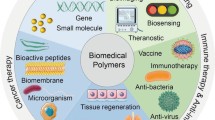Abstract
Coatings of biologically active molecules on synthetic “bulk” materials are of much interest for biomedical applications since they can in principle elicit specific, predictable. controlled responses of the host environment to an implanted device. However, issues such as shelf life. storage conditions, biological safety, and enzymatic attack in the biological environment must be considered; synthetic proteins may offer advantages. In this study we investigated the covalent immobilization onto polymeric materials of synthetic proteins which possess some properties that mimic those of the natural protein collagen, particularly the ability to form triple helical structures, and thus may provide similar bio-responses while avoiding enzymatic degradation. In order to perform immobilization of these collagen-like molecules (CLMs) under mild reaction conditions, the bulk materials are first equipped with suitable surface groups using rf plasma methods. Plasma polymer interlayers offer advantages as versatile reactive platforms for the immobilization of proteins and other biologically active molecules. Application of a thin plasma polymer coating from an aldehyde monomer is particularly suitable as it enables direct immobilization of CLMs by reaction with their terminal amine groups, using reductive amination chemistry. An alternative route is via plasma polymer layers that contain carboxylic acid groups and using carbodiimnide chemistry. A third route makes use of alkylamme plasma polymer interlayers, which are less process sensitive than aldehyde and acid plasma coatings. A layer of poly-carboxylic acid compounds such as carboxylic acid terminated PAMAM-starburst dendrimers or carboxymethylated dextran is then attached by carbodiimide chemistry onto the amine plasma layer. Amine-terminated CLMs can then be immobilized onto the poly-carboxylic acid layer. Surface analytical methods have been used to characterize the immobilization steps and to assess the surface coverage. Initial cell attachment and growth assays indicate that the biological performance of the CLMs depends on their amino acid sequence.
Similar content being viewed by others
References
“Primaria. A uniquely modified tissue culture surface that mimics in vivo conditions - in vitro”. Product information sheet, Becton Dickinson Labware, Lincoln Park, NJ. USA, 1986.
P. Nicolson et al., US Patent 5 760 100 (1995).
J.J. Grzesiak, M.D. Pierschbacher, M.F. Amodeo, T.I. Malaney, and J.R. Glass, Biomaterials 18, 1652 (1997).
A. El-Ghannam, L. Starr, and J. Jones, J. Biomed. Mater. Res. 41, 30 (1998).
J.A. Neff, K.D. Caldwell, and P.A. Tresco. J. Biomed. Mater. Res. 40, 511 (1998).
H-B. Lin, C. Garcia-Echeverria, S. Asakura, W. Sun, D.F. Mosher, and S.L. Cooper, Biomaterials 13, 905 (1992).
S.P. Massia and J. A. Hubbell, Anal. Biochem. 187, 292. (1990).
K.C. Olbrich, T.T. Andersen, F.A. Blumenstock and R. Bizios. Biomaterials 17, 759. (1996).
M. Huber, P. Heiduschka, S. Kienle, C. Pavlidis, J. Mack, T. Walk, G. Jung, and S. Thanos, J. Biomed. Mater. Res. 41, 278 (1998).
R.J. Simon, R.S. Kania, R.N. Zuckermann, V.D. Huebner, D.A. Jewell, S. Banville. S. Ng, L. Wang, S. Rosenberg, C.K. Marlowe, D.C. Spellmeyer, R. Tan, A.D. Frankel, D.V. Santi, F.E. Cohen, and P. A. Bartlett, Proc. Natl. Acad, Sci. USA 89, 9367 (1992).
M. Goodman, G. Melancini, and Y. Feng, J. Amer. Chem. Soc. 118, 10928 (1996).
G. Melacini, Y. Feng, and M. Goodman, J. Amer. Chem. Soc. 118, 10725 (1996).
Y. Feng, G. Melancini, J. Taulane, and M. Goodman, Biopolymers 39, 859 (1996).
Y. Feng, G Melancini, and M. Goodman, Biochemistry 36, 8716 (1997).
G.J. Beumer, R.C. Chatelier, H.A.W. St. John, and H.J. Griesser, Proc. 5th World Biomater. Congr., May 29- June2, Toronto, Canada. 1-881 (1996).
X. Gong and H.J. Griesser, Plasmas & Polym. 2, 261 (1997).
H.J. Griesser and R.C. Chatelier, J. Appl. Polym. Sci: Appl. Polym. Symp. 46, 361 (1990).
T.R. Gengenbach, Z.R. Vasic, R. C. Chatelier, and H.J. Griesser, J. Polym. Sci.. Pt A.: Polym. Chem. 32, 1399 (1994).
T.R. Gengenbach, R.C. Chatelier, and H.J. Griesser, Surf. Interf. Anal. 24, 271 (1996).
T.R. Gengenbach, R.C. Chatelier, and H.J. Griesser, Surf. Interf. Anal. 24, 611 (1996).
P. Kingshott, H.A.W. St John, R.C. Chatelier, and H.J. Griesser, J. Biomed. Mater. Res., submitted (1998).
M.D.M. Evans and J.G. Steele, Exp. Cell Res. 233, 88 (1997).
P.A. Underwood and F.A. Bennett, J. Cell Sci. 93, 641 (1989).
K.M. McLean, S.L. McArthur, R.C. Chatelier, P. Kingshott, and H.J. Griesser, Coll. Surf. B: Biointerfaces, submitted (1998).
Author information
Authors and Affiliations
Corresponding author
Rights and permissions
About this article
Cite this article
Griesser, H.J., McLean, K.M., Beumer, G.J. et al. Surface Immobilization of Synthetic Proteins Via Plasma Polymer Interlayers. MRS Online Proceedings Library 544, 9–20 (1998). https://doi.org/10.1557/PROC-544-9
Published:
Issue Date:
DOI: https://doi.org/10.1557/PROC-544-9




